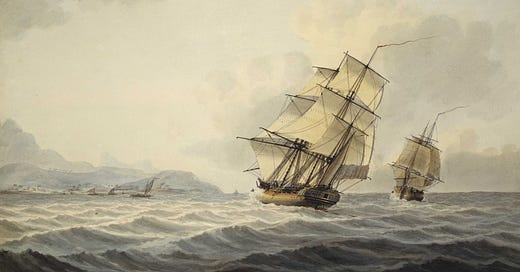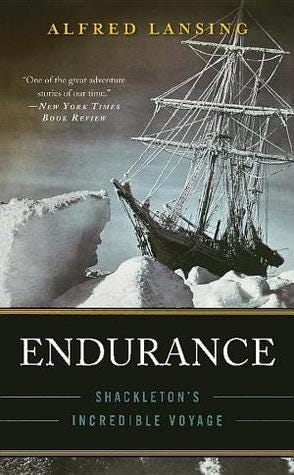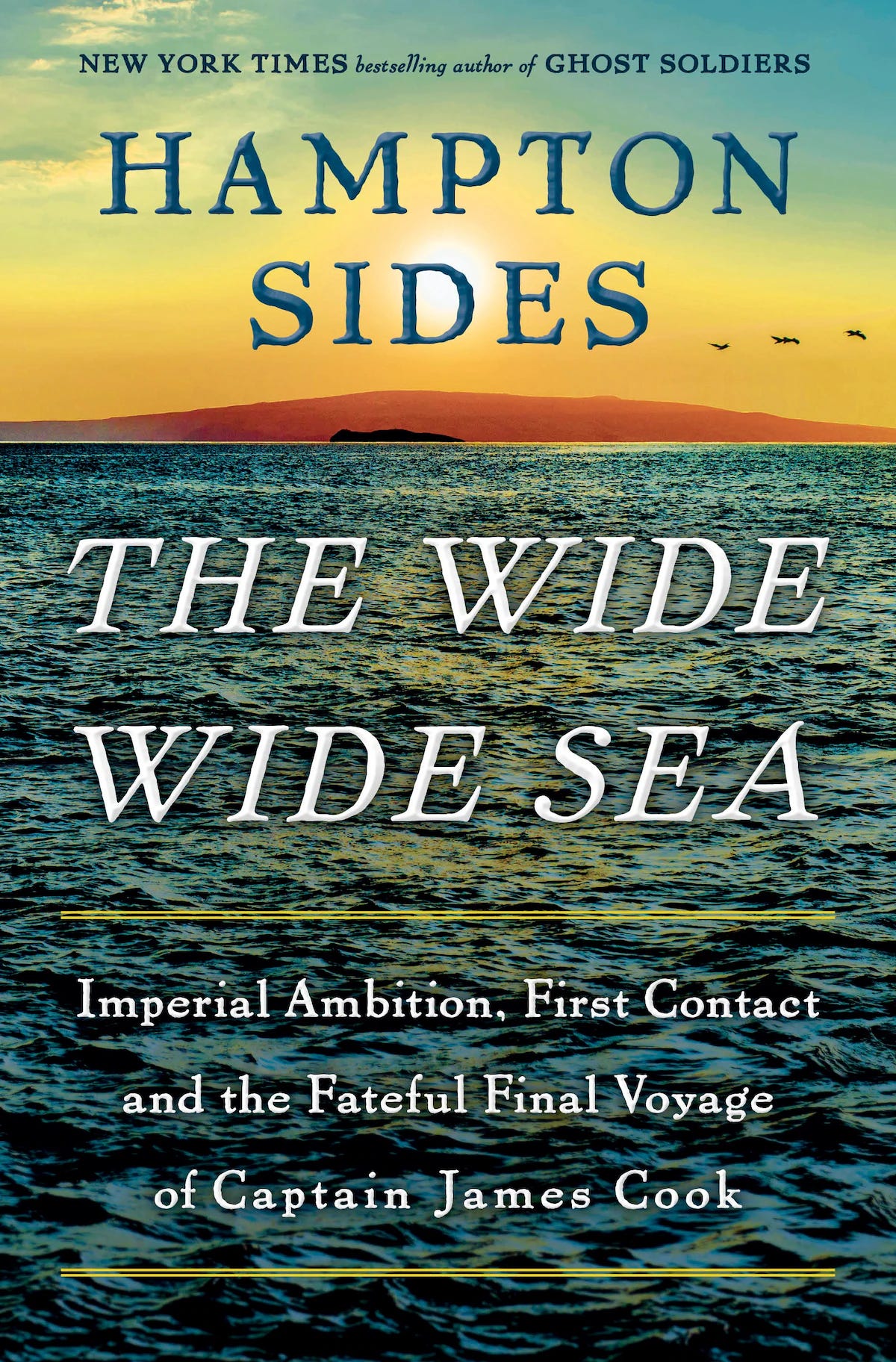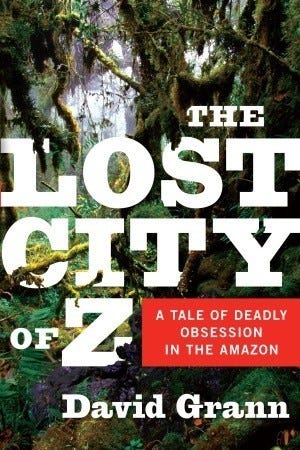The narrative-driven nonfiction book has become a popular and increasingly crowded sub-genre. Below are a few of my favorites about epic naval voyages or overland expeditions. These all read thrillers and difficult to put down!
Endurance: Shackleton’s Incredible Voyage by Alfred Lansing
Published in 1959, Endurance tells the harrowing story of Ernest Shackleton’s famous Antarctic expedition. In 1914, Shackleton and a crew of twenty-seven men set sail for Antarctic waters on the Endurance. They planned to be the first to cross the continent, but early on in the expedition, the Endurance became locked in a pack of sea ice. The ice eventually crushed the ship. More than twelve hundred miles lay between them and the nearest outpost of civilization. Lansing follows their attempt to reach safety.
Endurance is one of the best narrative nonfiction books I have ever read. It is gut-wrenching, suspenseful, thrilling, and often unbelievable. I was also shocked that this book is less than 300 pages, especially given the mountain of archival evidence Lansing used. Nonfiction writers often add too many asides that detract from the overall story. Lansing ruthlessly selected his material here — choosing the most illustrative moments of their journey and cutting out the clutter. It is definitely worth a read.
Rating: 5/5
Genre: Historical Nonfiction (Narrative)
Page count: 282 pages
Audio: 10 hours and 20 min
Movie/TV pairings: The Lost City of Z; Shackleton (a BBC mini-series from 2002); The Endurance (documentary)
The Wager: A Tale of Shipwreck, Mutiny and Murder by David Grann
In 1740, the HMS Wager, a British Royal Navy ship, sailed across the Atlantic on a secret mission to intercept a treasure-filled Spanish vessel off the Chilean coast. The English-Spanish war was raging — which was absurdly called the War of Jenkins’ Ear (named because it supposedly started when a Spanish sailor cut off a British sailor’s ear).
As they rounded Cape Horn, the crew suffered from typhus and scurvy. They intended to reach Robinson Crusoe Island, but the Wager shipwrecked on a remote island off the coast of Patagonia. That’s when the real story begins. Grann tells us at the outset that some of the survivors returned to England and were court-martialed. Was this a straightforward story of survival? Or did something more sinister happen? Was there mutiny? Murder? Or were they heroes?
Just read it!
Rating: 4.7/5
Genre: Historical Nonfiction (Narrative)
Notable prizes/book clubs/lists: National Book Award Finalist (1960)
Page count: 331 pages
Audio: 8 hours and 28 minutes
In the Heart of the Sea: The Tragedy of the Whaleship Essex by Nathaniel Philbrick
On a November day in 1820, an 80-foot bull sperm whale repeatedly rammed the 240-ton whaleship Essex. The ship splintered and shattered, leaving Captain George Pollard and his crew from Nantucket stranded in three tiny whaleboats in the middle of the South Pacific. This true story was the inspiration for Herman Melville’s Moby-Dick. However, while Moby-Dick ended with Ahab’s ship sinking, this whale attack was just the beginning for Pollard’s crew.
After losing the Essex, the officers debated where to sail in their ill-equipped boats. The closest islands, the Marquesas, were 1,000 miles away and downwind, but the officers feared the cannibals who supposedly inhabited the Marquesas. Captain Pollard wanted to sail to the Society Islands, about 2,000 miles away, but the other officers overruled him because of more cannibalism rumors. The South American coast was 2,000 miles away and upwind. In a decision that reflected their ignorance and xenophobia, the crew decided to make for the coast of South America. Philbrick reconstructs their attempt to reach safety.
Philbrick also weaves in details of the history of the whaling industry and Nantucket. In the 19th century, more than 200,000 sperm whales were harvested for their blubber, which was boiled into oil. This whale oil lit the streets and lubricated machinery before petroleum replaced it. However, the whaling industry continued well into the 20th century — at least 770,00 sperm whales were hunted in the 20th century.
This book has it all: shipwreck, madness, man against nature, hubris, actual cannibalism, and a rogue whale. It reads like a thriller, although the cannibalism parts were difficult to read. The Essex is an interesting foil to the Endurance. While the Endurance exemplifies teamwork and leadership, In the Heart of the Sea is the complete opposite—most of the crew do not survive the Essex, largely due to poor decision-making.
Overall, I definitely recommend this book to anyone who likes narrative historical nonfiction.
Rating: 4.5/5
Genre: Historical Nonfiction (Narrative)
Notable prizes/book clubs/lists: National Book Award for Nonfiction (2000)
Page count: 302 pages
Audio: 10 hours and 3 minutes
Movie/TV pairings: In 2015, this book was adapted into a Ron Howard movie starring Chris Hemsworth and Cillian Murphy, but it seems like Howard tried to merge elements of Moby-Dick with In the Heart of the Sea.
The Wide, Wide Sea: Imperial Ambition, First Contact and the Fateful Final Voyage of Captain James Cook by Hampton Sides
The Wide Wide Sea is a gripping account of Captain James Cook’s sprawling third and final voyage in search of the elusive Northwest Passage from 1776 to 1779. The ships traveled to present-day South Africa, South America, Australia, New Zealand, Polynesia, Hawaii, north to Alaska and beyond, and back to Hawaii.
Cook’s first two voyages were largely scientific. They made Cook, who had “risen from virtually nothing,” a celebrity in England. Cook was a talented cartographer, and his crew knew him as a restrained, orderly captain. Interestingly, given the ubiquity of Cook’s name, he never named landmarks after himself and chose native names whenever he learned of them.
His third voyage marked a departure from these initial expeditions. While Cook was a relatively measured captain during his first two expeditions, he acted erratically and often cruelly on this third voyage. When a local stole a goat from him, he sent his sailors on a multiday rampage to torch local villages.
The search for a Northwest Passage was also inextricably tied up with colonialism. Cook claimed land for England whenever he could, and he traveled with a large collection of plants, domesticated livestock, and birds to replicate the English countryside in remote lands. Among the crew was a man named Mai from Raiatea (present-day Tahiti). During Cook’s second voyage, Mai persuaded one of the captains to take him to England. He spent several years in England and was now returning to his homeland on this third expedition.
This book is fascinating and, at times, disturbing. Sides brings Cook’s hair-raising expedition to life in this book. But The Wide Wide Sea is not just an adventure tale. Sides also grapples with the legacy of colonialism. Sides takes a measured approach to this charged subject. However, this book can sometimes feel meandering. The digressions are largely due to the length and breadth of Cook’s journey. It also starts out a bit slow; Sides devotes considerable time to the expedition preparations at the beginning of the book. But by the end, I could not put it down.
Overall, I highly recommend this book. The Wide Wide Sea is engaging, informative, and thought-provoking.
Rating: 4.3/5
Genre: Historical Nonfiction (Narrative)
Notable prizes/book clubs/lists: Obama’s 2024 summer reading list
Page count: 408 pages
Audio: 15 hours and 41 minutes (British narrator).
The Lost City of Z: A Tale of Deadly Obsession in the Amazon by David Grann
In 1906, British explorer Colonel Percy Fawcett began exploring the Amazon. He was fascinated by the myths of El Dorado from the early Conquistadores. Fawcett believed there was a lost city (which he codenamed Z). In 1925, he set off with his son, Jack, and Jack’s friend, Raleigh Rimmell, to find Z. They disappeared and were never heard of again.
I read this book back when it was published in 2009 and loved it. But it’s not perfect. Because Fawcett disappeared, Grann draws his own conclusions about what possibly happened to Fawcett. I didn’t love this part. But this is an exciting and fast read, and I definitely recommend it!
Rating: 4/5
Genre: Historical Nonfiction (Narrative)
Notable prizes/book clubs/lists: NYT Top 10 Books (2009)
Page count: 339 pages
Audio: 10 hours and 4 minutes
Movie/TV pairings: This book was adapted into a movie, but the movie’s nothing special.
Hero of the Empire: The Boer War, a Daring Escape, and the Making of Winston Churchill by Candice Millard
Hero of the Empire chronicles Winston Churchill’s time as a young reporter covering the Second Boer War (1899-1902), a conflict between the British Empire and the two Boer republics (the South African Republic and the Orange Free State). Millard chronicles Churchill’s daring escape from a POW camp.
Churchill spent his early 20s trying to distinguish himself from his aristocratic family. He served as an officer in the British Army in both India and Sudan and worked as a journalist covering the 1895 Cuban uprising against the Spanish (his love of cigars started in Cuba). Millard writes that he “returned home every time without the medals that mattered, no more distinguished or famous than he had been when he set out.” Shortly before he left for South Africa, Churchill also ran for a seat in Parliament but lost the election.
At age 24, Churchill went to South Africa. True to his privileged roots, Churchill traveled with a personal valet and $4,000 of fine wine and spirits (18 bottles of St.-Émillion and 18 bottles of a 10-year-old scotch). While Churchill traveled with the fine comforts of home, the Second Boer War was a brutal guerrilla war. The British troops had to adapt to the Boers’ fighting style. They were forced to abandon their “redcoats” in favor of khaki to better blend into their surroundings (Burberry designed the officer uniforms and raincoats—the brand would later design their classic “trench coats” for WWI soldiers fighting in the trenches).
Just two weeks after Churchill arrived, Boers ambushed his train car and captured him. He spent a month as a prisoner of war before escaping. He left with no map and just “four slabs of melting chocolate and a crumbling biscuit” in his pocket. Nevertheless, he managed to travel through 300 miles of enemy territory back to the British troops. His audacious escape captured the British press’s attention (this was partly due to the lack of feel-good stories about the British troops).
In a particularly engaging epilogue, Millard explains how Churchill reenlisted in the army and liberated the POW camp from which he escaped. He finally earned the recognition he yearned for and subsequently won his first election in 1900 when he returned to England.
While it is easy to get swept up in Churchill’s movie-worthy escape, Millard also discusses the human cost of the war in the epilogue. Millard writes, “Some thirty thousand Boer farms would be left in black, smoldering ruins.” The British put the displaced Boers (primarily women and children) in concentration camps. The concept of a concentration camp was not new, but it was the first time the term was used. As Millard explains,
More than that, it was the first time the camps had targeted a whole country and depopulated entire regions. Although the British did not intentionally kill their captives, they committed . . . “slow murder.” The camps quickly multiplied until there were some 45 of them scatted across South Africa. They did not have nearly enough food for their thousands of inmates. There was little to no medical care, and the sanitary conditions were not only appalling, but deadly. By the end of the war, more than 26,000 Boer civilians would die in British concentration camps, some 22,000 of whom were children. Those statistics, however, do not even take into account the roughly 20,000 Africans who, having been forced to fight in a war that was not their own, subsequently died in separate black concentration camps.
Opinion: Hero of the Empire is the first book by Candice Millard I’ve read. She takes what might at first blush seem like a peripheral episode in Churchill’s prominent life and writes about it in cinematic prose. While there are some slow sections, the best parts of this book read like a thriller. I love the writing style and felt completely immersed in Churchill’s world and life. I definitely recommend this to anyone who loves narrative nonfiction or any Winston Churchill fan.
Rating: 4/5
Genre: Narrative Nonfiction
Page count: 416 pages
Audio: 10 hours 14 minutes
Food pairings: Chocolate bar










